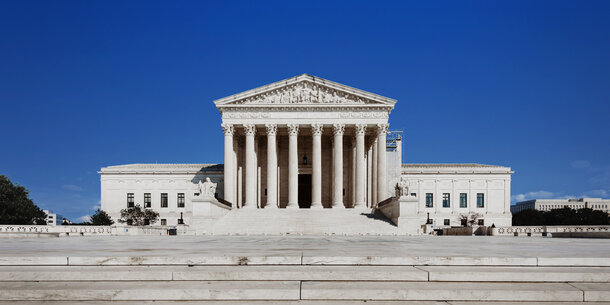For centuries, the United States denied Native Americans full and equal participation in federal elections. Reflecting this history, Native voter turnout consistently lags that of other groups. This report uses millions of voter records from 2012 to 2022 to document growing disparities in voter participation between people who live on Native American tribal lands and those who do not. Voter turnout during that period was substantially lower for people living on tribal lands, particularly those where Native Americans are concentrated.
One hundred years ago, in 1924, Congress passed the Indian Citizenship Act, which conferred citizenship on Native Americans born in the United States. Voting rights, however, were still dictated by state law, allowing continued exclusion and discrimination. Some states disenfranchised Native Americans who did not pay state taxes or required people to sever ties with their tribal nations to be eligible to vote. Others used strategies, such as literacy tests and gerrymandering, that were superficially race neutral yet had a greater impact on people of color. 1 Collectively, state laws stifled Native American political influence by limiting political participation to those who fully integrated into mainstream U.S. culture and by enacting policies that inhibited Native community building. 2
The Voting Rights Act of 1965 instituted federal oversight of state voting policies and curbed generations of race-based disenfranchisement. The law drastically increased voter registration and turnout among Black and Latino people nationwide. 3 However, it did not address many of the unique barriers faced by Indigenous communities.
Native American voter participation did not particularly benefit from the Voting Rights Act until 1975, when Congress added Section 203 to the law. The provision extended coverage to “language minorities,” which included Native Americans. The minority language provisions of Section 203 require, in jurisdictions with a certain percentage of voters with limited English proficiency, that election material and oral assistance be provided in non-English languages, including traditional Indigenous languages. 4 Section 203, and subsequent lawsuits to implement it, increased rates of registration and turnout in some jurisdictions. 5
Despite such progress, the difficulty in using the Voting Rights Act to address other issues, like the immense distances to polling places for residents of tribal lands, continues to produce disparities in voter turnout.
Inadequate collection of data on Native Americans has resulted in limited research into the quantitative effect of the compounded barriers to voting that these citizens face. Given these limitations, this report takes a novel approach to studying Native American political participation in U.S. elections. There are nearly 1.3 million American Indian or Alaska Native people living on federally recognized tribal lands in the United States. 6 We use snapshots of state voter records from 2012 to 2022 for 21 states with populous tribal lands. We use data on U.S. Census–designated, federally recognized American Indian Reservations, which we refer to broadly as tribal lands.
Tribal lands are racially and ethnically diverse and do not collectively represent the 10 million people who identify as American Indian or Alaska Native. As a result of mid-
century termination policies, during which the federal government ceased to recognize more than 100 tribes’ sovereignty, hundreds of thousands of Native Americans were forced to relocate to urban areas. 7 However, it still remains crucial to understand how hurdles to participation on tribal lands impact the 13 percent of Native Americans who live there. 8 Of the tribal lands we study, 53 percent of the population in 2020 identified as Native. Many of the barriers faced by residents of tribal lands, like the denial of tribal identification cards as acceptable forms of voter ID, are relics of discrimination that have gone unaddressed by governments at all levels and weaken the voting strength of Native communities. 9
The geographic isolation of rural tribal lands is one of the largest obstacles to voting. Election offices are typically located outside of tribal lands; for instance, on the Pyramid-Lake Reservation in Nevada and the portion of the Navajo Nation in Utah, these offices are more than 100 miles away. 10 Some reservation residents, like members of the Karuk Tribe in California, must drive across dangerous terrain to access their county seats for election services. 11
Voting by mail is also difficult. Many tribal lands use nonstandard addresses that do not contain house numbers or street names and often go unserved by postal carriers. To overcome this, some voters share post office boxes; however, several jurisdictions do not mail ballots to P.O. boxes. 12 Moreover, most post offices are far from homes on tribal lands and have limited hours of operation. 13
In addition, many tribal land residents face exacerbated socioeconomic vulnerabilities, such as low levels of postsecondary education and high rates of household poverty and homelessness. 14 People who struggle with such conditions often lack the resources required to vote and thus are less likely to cast ballots. 15
These long-standing factors make tribal lands a critical case study on systemic inequities in election administration. Our study finds that, from 2012 to 2022, average turnout among individuals who live on tribal lands was 11 percentage points lower than that of their off-tribal-land counterparts. In 2020, for example, had the nearly 900,000 voters on the tribal lands we studied turned out at the same rate as others in their states, roughly 160,000 more votes would have been cast. In addition, turnout was lower on tribal lands with higher shares of Native American adults. Voters on tribal lands were also 7 percentage points less likely than those not on tribal lands to vote by mail or vote early. The U.S. government’s persistent inaction to improve voting conditions for Native Americans has resulted in widespread disenfranchisement and furthered a legacy of mistrust in the political system. 16
Endnotes
-
1
Jean Schroedel and Ryan Hart, “Vote Dilution and Suppression in Indian Country,” Studies in American Political Development 29, no. 1 (April 2015): 40–67, https://doi.org/10.1017/S0898588X1400011X; Daniel McCool, Susan M. Olson, and Jennifer L. Robinson, Native Vote: American Indians, the Voting Rights Act, and the Right to Vote (Cambridge, UK: Cambridge University Press, 2007), http://dx.doi.org/10.1017/CBO9780511811821; Jeanette Wolfley, “Jim Crow, Indian Style: The Disenfranchisement of Native Americans,” American Indian Law Review 16, no. 1 (1991): 167–202, https://doi.org/10.2307/20068694; and Jean Schroedel and Artour Aslanian, “Native American Vote Suppression: The Case of South Dakota,” Race, Gender & Class 22, no. 1–2 (2015): 308–323, https://www.jstor.org/stable/26505340.
-
2
James Thomas Tucker, Jacqueline De León, and Daniel McCool, Obstacles at Every Turn: Barriers to Political Participation Faced by Native American Voters, Native American Rights Fund, June 2020, https://vote.narf.org/obstacles-at-every-turn.
-
3
Bernard L. Fraga and Julie Lee Merseth, “Examining the Causal Impact of the Voting Rights Act Language Minority Provisions,” Journal of Race, Ethnicity, and Politics 1, no. 1 (March 2016): 31–59, https://doi.org/10.1017/rep.2015.1; Richard L. Engstrom, “Shelby County v. Holder and the Gutting of Federal Preclearance of Election Law Changes,” Politics, Groups, and Identities 2, no. 3 (July 3, 2014): 530–48, https://doi.org/10.1080/21565503.2014.940545; and J. Morgan Kousser, “The Strange, Ironic Career of Section 5 of the Voting Rights Act, 1965–2007,” Texas Law Review 86 (March 2008): 667, https://heinonline.org/HOL/LandingPage?handle=hein.journals/tlr86&div=25&id=&page=.
-
4
Federal Register, “Voting Rights Act Amendments of 2006, Determinations Under Section 203,” December 8, 2021, https://www.federalregister.gov/documents/2021/12/08/2021–26547/voting-rights-act-amendments-of-2006-determinations-under-section-203.
-
5
Tucker, De León, and McCool, Obstacles at Every Turn, 58.
-
6
U.S. Census Bureau, American Indians and Alaska Natives in the United States, U.S. Department of Commerce, 2022, https://www2.census.gov/geo/maps/DC2020/AIANWall2020/2020_AIAN_US.pdf.
-
7
American Archive of Public Broadcasting, “Native Narratives: The Representation of Native Americans in Public Broadcasting — Termination, Relocation, and Restoration,” 2024, https://americanarchive.org/exhibits/native-narratives/termination-relocation-restoration; Charles F. Wilkinson and Eric R. Biggs, “The Evolution of the Termination Policy,” American Indian Law Review 5, no. 1 (1977): 139–84, http://dx.doi.org/10.2307/20068014; Roberta Ulrich, American Indian Nations from Termination to Restoration, 1953–2006 (Lincoln, NE: University of Nebraska Press, 2010); and Urban Indian Health Institute, “Urban Indian Health,” March 17, 2022, https://www.uihi.org/urban-indian-health/.
-
8
U.S. Census Bureau, American Indians and Alaska Natives in the United States.
-
9
Matt Barreto, Gabriel R Sanchez, and Hannah Walker, “Battling the Hydra: The Disparate Impact of Voter ID Requirements in North Dakota,” Journal of Race, Ethnicity and Politics 7, no. 1 (March 2022): 119–40, https://doi.org/doi:10.1017/rep.2022.1.
-
10
Tucker, De León, and McCool, Obstacles at Every Turn, 33.
-
11
Tucker, De León, and McCool, Obstacles at Every Turn, 31.
-
12
Tucker, De León, and McCool, Obstacles at Every Turn, 95.
-
13
Melissa Rogers, Jean Schroedel, and Joseph Dietrich, “Inequalities in Vote by Mail for Native Americans in the US West: The Historical Political Economy of Postal Service in Northeastern Arizona,” Journal of Historical Political Economy 2, no. 4 (February 5, 2023): 553–81, https://doi.org/10.1561/115.00000040.”
-
14
U.S. Department of Agriculture, “Many American Indians and Alaska Natives Are Concentrated in High Poverty Rural Areas,” last updated November 25, 2022, https://www.ers.usda.gov/data-products/chart-gallery/gallery/chart-detail/?chartId=105269; and National Caucus of Native American State Legislators, Striving to Achieve: Helping Native American Students Succeed, 2008, https://documents.ncsl.org/wwwncsl/LegislativeStaff/Quad-Caucus/strivingtoachieve.pdf.
-
15
Cathy J. Cohen and Michael C. Dawson, “Neighborhood Poverty and African American Politics,” American Political Science Review 87, no. 2 (1993): 286–302, https://doi.org/10.2307/2939041; and Sidney Verba et al., “Race, Ethnicity and Political Resources: Participation in the United States,” British Journal of Political Science 23, no. 4 (1993): 453–97, http://dx.doi.org/10.1017/S0007123400006694.
-
16
Jean Schroedel et al., “Political Trust and Native American Electoral Participation: An Analysis of Survey Data from Nevada and South Dakota,” Social Science Quarterly 101, no. 5 (2020): 1885–1904, http://dx.doi.org/10.1111/ssqu.12840.




